YAZILIKAYA - RELIEF
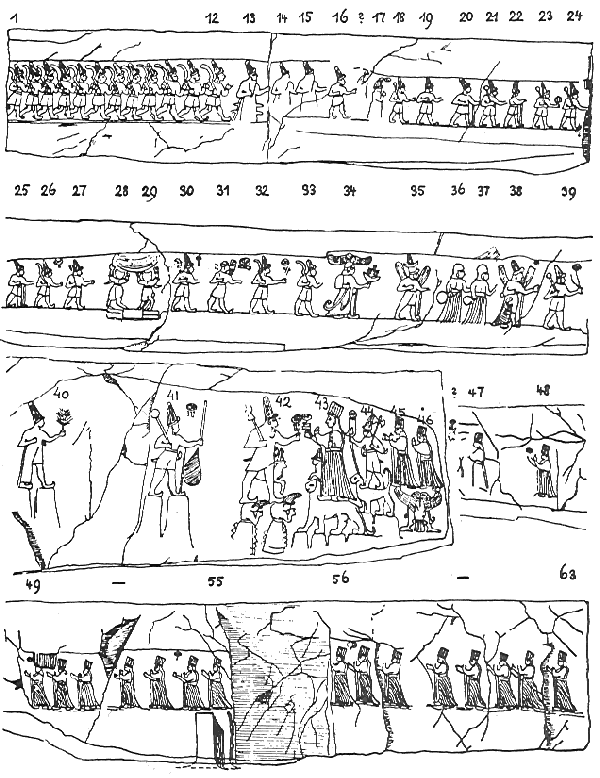
Rock sanctuary at Yazılıkaya. Sixty-three deities representing a
reduced version of the "thousand gods" of the Hittite Empire.
The gods (1-42) are depicted on the west and the goddesses (43-63)
on the east side of the gallery. The chief divinities are portrayed in the main scene on
the north wall (40-46). As they appear in profile, they are generally
described as being in a procession. However, it must be understood that, with the
exception of the monument of Eflatunpınar, it was not customary in Hittite art to carve
front views of figures. Therefore, we do not consider these deities to be marching in a
procession nor advancing to meet one another. Rather, we believe that the artist meant his
figures to be standing ceremonially in front of the beholder. The division into groups of
male and female deities is not rigid. Three goddesses stand among the gods (36-38),
and one god (44) is observed in the row of goddesses. The 42 gods
represented start on the left of the entrance to the gallery with a relief consisting of
12 figures. (13-27) These gods are not clearly identified. 28
and 29 show two bull men standing on the hieroglyphic symbol for the
earth and supporting the sky. 34) Representation of a deified king with
the hieroglyphic signs of the Sun God of Heaven (see also personification
of divine kingship). 35) Moon God. 36, 37)
Ninatto and Kulitta, handmaids to Ishtar. 38) Shaushga, the Hurrian
Ishtar. 39) Ea, Mesopotamian God of Water and an important deity in the
Hurrion religion. 40) God of Grain, holding an ear of corn. 41)
Weather God of Hattusa. 42) Weather God of Heaven (Weather God of Hati). 43)
Hepatu. 44) Sharruma. 47) Hutena. 48)
Hutellura. 49) Nabarbi. 56) A sculptured block
representing Ishtar-Shaushga, found in Yekbaz, a neighboring village, now leaning against
the wall below the row of goddesses. Very probably originally from the gap between 55 and
56.
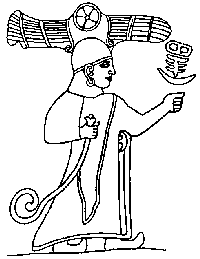 Personification of the divine kingship.
This relief at Yazılıkaya represents the figure of a king with hieroglyphic
symbols of the Sun God of Heaven (No. 34). Kingship is indicated by the winged
sun-disc and the kalmush, the long staff curved at the end. Both of these, according to
the texts, were signs of sovereignty. The round skull-cap and the cloak further identify
this figure as. a monarch. (See also the portrayals of Tudhaliya, Sharruma). On the other hand, the hieroglyphic symbols designate him as
the Sun God of Heaven. Owing to the absence of ideograms for an individual name, this
figure seems to be the image of a deified ruler in a general sense. Consequently, it
symbolically represented the monarch in power in each period. Personification of the divine kingship.
This relief at Yazılıkaya represents the figure of a king with hieroglyphic
symbols of the Sun God of Heaven (No. 34). Kingship is indicated by the winged
sun-disc and the kalmush, the long staff curved at the end. Both of these, according to
the texts, were signs of sovereignty. The round skull-cap and the cloak further identify
this figure as. a monarch. (See also the portrayals of Tudhaliya, Sharruma). On the other hand, the hieroglyphic symbols designate him as
the Sun God of Heaven. Owing to the absence of ideograms for an individual name, this
figure seems to be the image of a deified ruler in a general sense. Consequently, it
symbolically represented the monarch in power in each period.
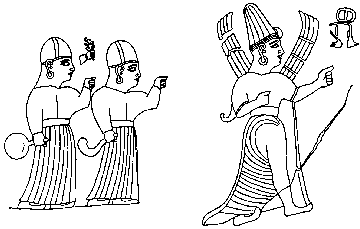 Ishtar, accompanied by her attendants (Nos. 38,
37, 36). The great Babylonian goddess Ishtar was worshipped in Anatolia under the Hurrion
name of Shaushga. She was the sister of Teshup and held sway as the Goddess of Low and
War. She appears here with her attendants, the goddesses Ninatto and Kulitta, as the
Hurrion Goddess of War. In her place among the mate deities at Yazılıkaya, she wears,
like them, a pointed cap with one horn and bears an axe (this is absent in the
illustration given here). She was represented unarmed in the row of female deities at
Yazılıkaya, in her capacity as the Goddess of Low. The latter relief now rests on the
ground below the figures of the female divinities. The hieroglyphic ideograms accompanying
the two portrayals of the goddess are identical. Ishtar, accompanied by her attendants (Nos. 38,
37, 36). The great Babylonian goddess Ishtar was worshipped in Anatolia under the Hurrion
name of Shaushga. She was the sister of Teshup and held sway as the Goddess of Low and
War. She appears here with her attendants, the goddesses Ninatto and Kulitta, as the
Hurrion Goddess of War. In her place among the mate deities at Yazılıkaya, she wears,
like them, a pointed cap with one horn and bears an axe (this is absent in the
illustration given here). She was represented unarmed in the row of female deities at
Yazılıkaya, in her capacity as the Goddess of Low. The latter relief now rests on the
ground below the figures of the female divinities. The hieroglyphic ideograms accompanying
the two portrayals of the goddess are identical.
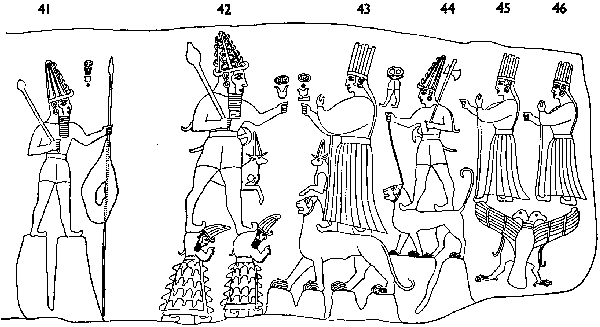
The main scene in the shrine at Yazılıkaya (Nos. 40-46 and view of rock sanctuary)
41) Weather God of Hattusa, standing on two mountain peaks. 42)
Weather God of Heaven, astride the deified mountains, Nanni and Hazzi. He possessed two
sacred bulls called Serri and Hurri, one of which accompanies him here, while the other is
shown with his consort Hepat (43). In the Hurrion language, Serri and Hurri mean,
respectively, day and night. Hazzi is the Mons Cassius near Antakya, which was in Hurrian
country. In view of these religious elements and the Hurrian name of his spouse (43), one
may be sure the god was intended to be known by his Hurrian appellation, that is,
"Teshub", although his name appears here in the usual Hittite ideograms, which
mean the "Weather God of Heaven". As the highest ranking god in the hierarchy,
his cap is adorned with five superimposed god-ideograms (half ellipses) and six horns at
the front and back, while the Weather God of Hattusa (41) and the god Sharruma (44) are
permitted to wear pointed caps with only six frontal horns in the chief god's. presence. 43)
The leading female deity of the Hittite Empire, the Sun Goddess of Arinno, wife of the
Weather God of Heaven, bears the Hurrian name of Hepatu, at Yozılıkaya clearly written
in the hieroglyphic script as it should be pronounced. Like the other female deities, she
wears a high polos, ending in the form of a Greek city crown; but hers is much higher than
those of the other goddesses. She is shown standing on a panther. 44) The
God Sharruma. He usually appears with his mother Hepatu. The Hurrian texts record that he
is the son of Teshub. Like his mother, he also stands on a panther. He carries a
long-handled axe, resting on his shoulder. 45, 46) The
two goddesses standing on a double-headed eagle have not been identified as yet. The three
divinities Nos. 42-44 form a triad, composed of father, mother, and son. When
participating in the erection of this sanctuary, the ambitious Puduhepa probably identified her husband Hattusili III with Teshub, herself with Hepatu and her son
Tudhaliya IV with Sharruma.
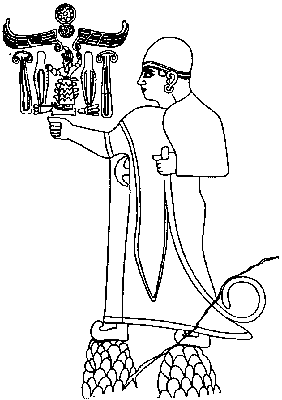
A place of particular significance in the great gallery is occupied by the relief (No.
64) of King Tudhaliya IV (1250-1220 B. C.). It is the largest relief in
the gallery. He is represented armed, wearing a skull-cap and holding in his left hand a
kalmush, the sign of sovereignty. The two antithetic hieroglyphs in the form of an Ionic
capital mean "Great King". The name of this king, which was originally that of a
sacred mountain, is expressed by the figure in the middle and the sign below it. Since
other holy mountains existed, such as Arnuwanda and Ammttna, and all were represented by
the same figure as this appearing here, the sculptors has added the signe below it, which
corresponds phonetically with the syllable "tu". Thus the beholder understood
that this picture represented King Tudhaliya. Standing on two mountain peaks, Tudhaliya is
depicted here as a deified king. According to Hittite texts, a king became a god after
death. However, the impression of a seat, found in Ras Shamra, in which he is shown
wearing a pointed cap adorned with horns, clearly -reveals that Tudhatiya allowed himself
to be represented as a god. Therefore, this picture of Tudhaliya at Yazılıkaya was quite
possibly carved in his lifetime.
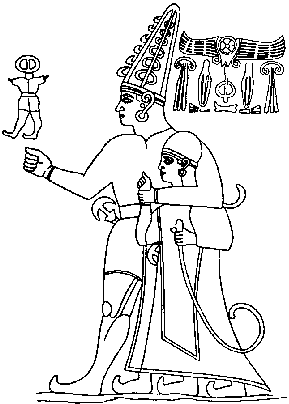 The scene in which the
god Sharruma holds King Tudhaliya in his embrace is one
of the most beautiful relief in the sanctuary at Yazılıkaya (plan of
Yazılıkaya, small gallery, No. 81). As understood from the testament of Hattusiti I,
the embrace was a gesture signifying honour and protection. Sharruma's pointed cap is
adorned with god-ideograms, unlike the plainer one he is shown wearing in his portrayal in
the main scene in the great gallery (main scene, No. 44). This is
possibly because he is not in the presence of the Weather God of Heaven and, therefore,
can allow himself to wear headgear showing marks of a higher rank. However, his cap is not
adorned at the back, and so still possesses fewer horns than that of the Weather God of
Heaven. Thus the hierarchy is respected. The hieroglyphs of Sharruma, indicating his name,
consist of a god-ideogram and a headless body. The scene in which the
god Sharruma holds King Tudhaliya in his embrace is one
of the most beautiful relief in the sanctuary at Yazılıkaya (plan of
Yazılıkaya, small gallery, No. 81). As understood from the testament of Hattusiti I,
the embrace was a gesture signifying honour and protection. Sharruma's pointed cap is
adorned with god-ideograms, unlike the plainer one he is shown wearing in his portrayal in
the main scene in the great gallery (main scene, No. 44). This is
possibly because he is not in the presence of the Weather God of Heaven and, therefore,
can allow himself to wear headgear showing marks of a higher rank. However, his cap is not
adorned at the back, and so still possesses fewer horns than that of the Weather God of
Heaven. Thus the hierarchy is respected. The hieroglyphs of Sharruma, indicating his name,
consist of a god-ideogram and a headless body.
Güterbock interpreted them as Sharruma not only because this figure, following Hepatu
(main scene, No. 44), is, according to the texts, most probably
Sharruma, but also because the two parallel strokes on either side of his shoulders are to
be read as "ma". The same sign occurs as the last syllable of the hieroglyphic
signs of the name "Suppiluliuma", which was deciphered with the assistance of
bilingual inscriptions on royal seats found in the excavations at Hattusa.
This relief is an exquisite example of Hittite art. We may admire the mastery of the
calligraphic outlines, which were the strong point of the Hittite sculptors. The pyramidal
composition is most successful. The figures rest on a rhythmic horizontal line, achieved
by the alignment of up-turned shoes. The vertical edges of the garments and the ruler's
staff merge into the rounded forms of the bodies of the king and the god. The pointed cap
of the god, with its superimposed horns and god-ideograms, counterbalances the horizontal
rhythm of up-turned shoes with a vertical movement and with its harmonious proportions
provides a graceful finale to the entire composition.
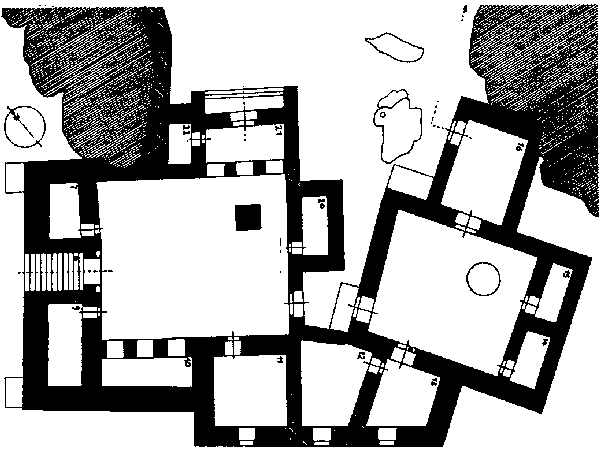
Temple of Yazılıkaya. Third phase. Probably erected by Tudhaliya IV.

 The relief of twelve gods in the small gallery (plan of Yazılıkaya, Nos. 69-80) is in a very good
state of preservation. It is covered with a brownish yellow patina, like the figures of Ninatta and Kulitta and that of the deified Tudhaliya. The Hittite
sculptor has achieved the effect of figures marching side by side in parade by the device
of overlapping the limbs. The relief of twelve gods in the small gallery (plan of Yazılıkaya, Nos. 69-80) is in a very good
state of preservation. It is covered with a brownish yellow patina, like the figures of Ninatta and Kulitta and that of the deified Tudhaliya. The Hittite
sculptor has achieved the effect of figures marching side by side in parade by the device
of overlapping the limbs.
Up to the present there has been no satisfactory answer concerning the religious
significance of the Sword God (plan of Yazılıkaya,
No. 82).
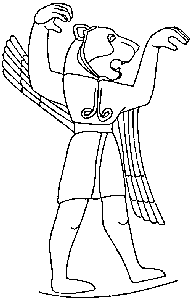 Two hybrid figures, depicted on either side of
the entrance (plan of Yazılıkaya, Nos. 67-68 not shown, however, on
our plan) giving access to the smaller gallery, were supposed to protect, in an apotropoic
sense, the mortuary chamber reserved for royal cult. Two hybrid figures, depicted on either side of
the entrance (plan of Yazılıkaya, Nos. 67-68 not shown, however, on
our plan) giving access to the smaller gallery, were supposed to protect, in an apotropoic
sense, the mortuary chamber reserved for royal cult.
|